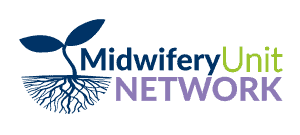Resources
MUNet aims to promote and support the implementation, development and growth of midwifery units. We want midwifery units to become the main care pathway for healthy women with straightforward pregnancies.
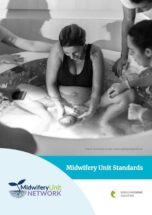
The aim of the Midwifery Unit Standards is to improve the quality of maternity care, reduce variability of practices and facilitate a bio-psycho-social model of care. They address the guidance gap in implementation...
| Size | 2.03 MB |
| Downloaded | 8933 times |
| Last Updated | 29th July 2020 |
Download | |
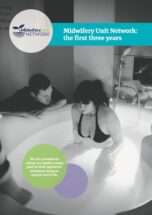
This report, prepared for our London 2018 conference, celebrates what we have achieved during our first three years and describes our plans for the future. It sets out our latest vision, mission and values....
| Size | 3.26 MB |
| Downloaded | 83 times |
| Last Updated | 13th July 2020 |
Download | |

The aim of the Midwifery Unit Standards is to improve the quality of maternity care, reduce variability of practices and facilitate a bio-psycho-social model of care. They address the guidance gap in implementation...
| Size | 2.03 MB |
| Downloaded | 8933 times |
| Last Updated | 29th July 2020 |
Download | |

This report, prepared for our London 2018 conference, celebrates what we have achieved during our first three years and describes our plans for the future. It sets out our latest vision, mission and values....
| Size | 3.26 MB |
| Downloaded | 83 times |
| Last Updated | 13th July 2020 |
Download | |
Policy
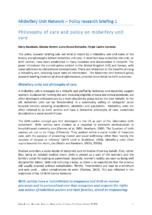
This policy research briefing sets out what is meant by a midwifery unit and some of the history and philosophy behind midwifery unit care. It describes how midwifery-led units have been established in...
| Size | 180.06 KB |
| Downloaded | 4182 times |
| Last Updated | 10th October 2018 |
Download | |
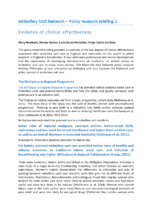
This policy research briefing provides a summary of the clinical effectiveness associated with midwifery unit care in England, and comments on the extent to which research in England is transferable to...
| Size | 152.37 KB |
| Downloaded | 107 times |
| Last Updated | 10th October 2018 |
Download | |
Better Births: Improving outcomes of maternity services in England.
A Five Year Forward View for maternity care. NHS England 2016
The report of a major consultation and review of maternity services in England and Wales, published in 2016.
NCT is a UK charity providing information and support to parents. This document discusses the social model of care, the environment and facilities available in birth centres, and who can book care in a birth centre. It summarises latest outcomes evidence associated with both freestanding and alongside midwifery units, including costs and cost effectiveness.
Quality Standards
This quality standard, produced by the English National Institute for Health and Care Excellence (NICE) describes high-quality care in priority areas. It covers the care of women and their babies during labour and immediately after the birth and includes women who go into labour at term, women at low risk of complications during labour and those who go on to develop complications.
The Birthplace In England research programme and related studies
The strongest evidence we have to date on the safety of different planned places of birth in England. The Birthplace cohort study compared the safety of births planned in four settings: home, freestanding midwifery units (FMUs), alongside midwifery units (AMUs) and obstetric units (OUs). The main findings relate to healthy women with straightforward pregnancies who meet the NICE intrapartum care guideline criteria for a ‘low risk’ birth.
The findings of the national prospective cohort study component of the Birthplace in England Research Programme, comparing perinatal outcomes, maternal outcomes, and interventions in labour by planned place of birth at the start of care in labour for women with low risk pregnancies.
A large ethnographic study of birth in four NHS Trusts England, including staff experiences of work and women and their partners’ experiences of birth in midwifery units.
A ethnographic study focussing on the organisation, care and user experiences in four Alongside Midwifery Units in England.
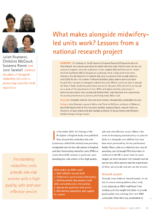
A summary, written for midwives, of the findings from the organisational case studies of alongside midwifery units. This short article outlines practical suggestions for what may help AMUs function effectively. ...
| Size | 188.92 KB |
| Downloaded | 102 times |
| Last Updated | 10th October 2018 |
Download | |
Published Research
General
Reference: Kirkham M (2003) Birth centres: a social model for maternity care. Books for Midwives.
Reference: Walsh D (2006) ‘Improving Maternity Services: the epidemiologically based needs assessment reviews, Vol 2: Small is Beautiful – lessons from a birth centre’. CRC Press
Service Users
Reference: Coxon, K. (2012) ‘Making evidence about risks and benefits accessible to parents’ NCT Perspective. Issue 16
Reference: McFarlane, A. J. et al. (2014) ‘Survey of women’s experiences of care in a new freestanding midwifery unit in an inner city area of London, England – 1: Methods and women’s overall ratings of care’ Midwifery 30 (9): 998-1008
Reference: Hinton, L., Dumelow, C., Rowe, R. and Hollowell, J. (2018) ‘Birthplace choices: what are the information needs of women when choosing where to give birth in England? A qualitative study using online and face to face focus groups’ BMC Pregnancy and Childbirth 18 (12)
Staffing, Workforce, Skills & Training
A report on a study exploring the relationships between staffing models and clinical outcomes in English maternity services.
Reference: Sandall et al (2014) ‘The efficient use of the maternity workforce and the implications for safety and quality in maternity care: a population-based, cross-sectional study’. Health Services & Delivery Research. Vol 2 Issue 38.
Conference Presentations
Further details, hand outs and presentations are available here.
